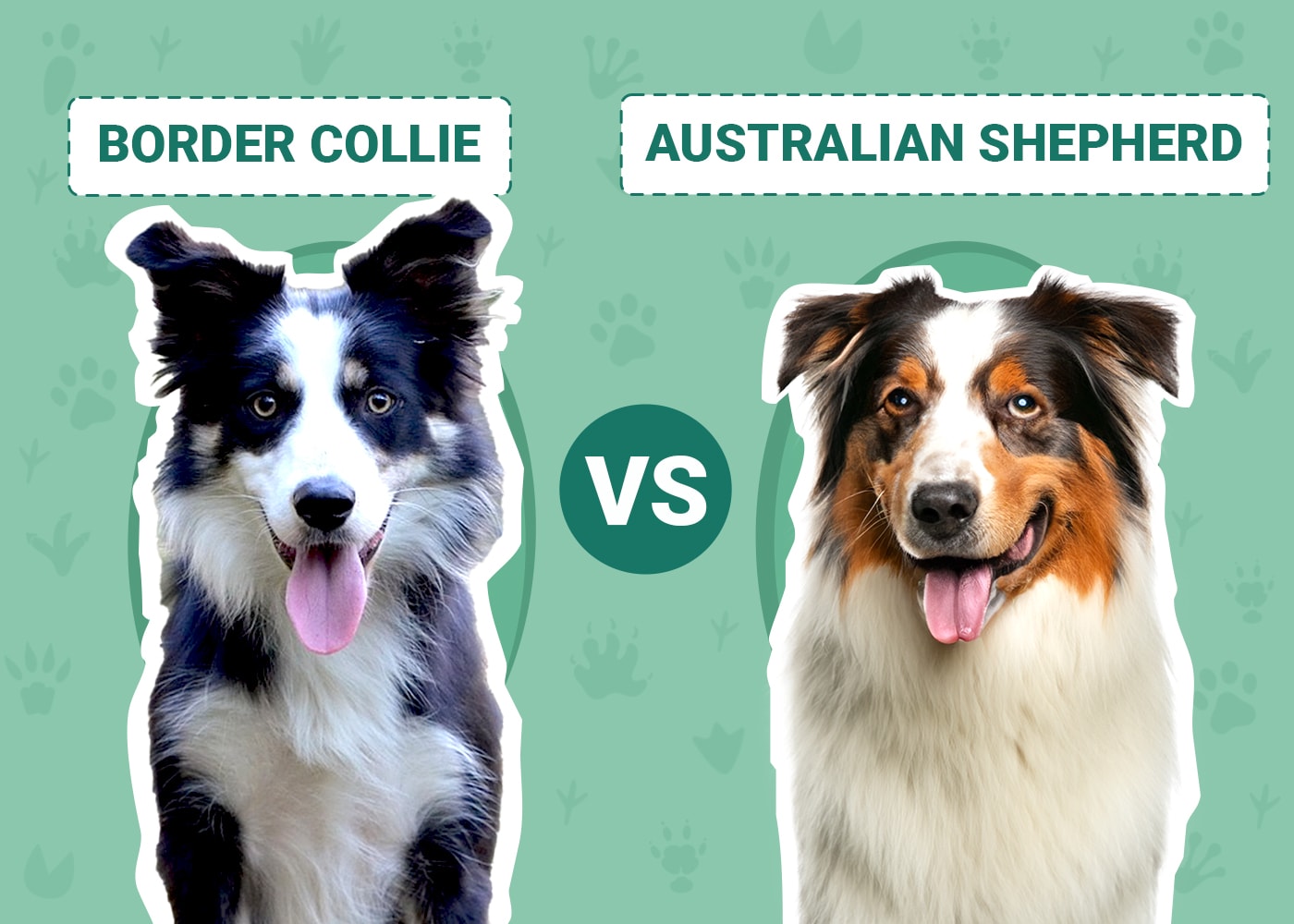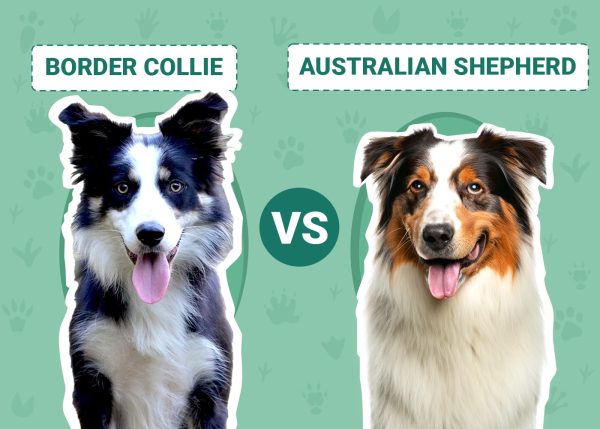Click to Skip Ahead
Border Collies and Australian Shepherds are fantastic dogs that are full of energy and are well-known for their intelligence and trainability. If you’re in the market for an active, smart pup, you may be torn between these two breeds.
Although often compared to each other, Border Collies and Aussies have notable differences, so it’s important to understand them when choosing between the two. You’ll need to consider which breed will best suit your family, your pets, and your lifestyle.

Visual Differences

At a Glance
- Average height (adult): 18–22 inches
- Average weight (adult): 27–45 pounds
- Lifespan: 12–15 years
- Exercise: 2+ hours a day
- Grooming needs: Moderate
- Family-friendly: Often
- Other pet-friendly: Often
- Trainability: High
- Average height (adult): 18–23 inches
- Average weight (adult): 30–65 pounds
- Lifespan: 13–15 years
- Exercise: 1+ hours a day
- Grooming needs: Moderate
- Family-friendly: Yes
- Other pet-friendly: Often
- Trainability: High
Border Collie Overview
Temperament
Border Collies are loyal dogs that bond very closely with their owners. They are good with children but may become nippy and poorly behaved without enough exercise. They are known for being wary of strangers, so they can be uncomfortable with visitors, including unfamiliar children.
They are highly energetic and trainable and excel in canine sports. They have a strong herding instinct bred into them, so helping appease this instinct through games and activities will maintain your Border Collie’s social and loving nature.
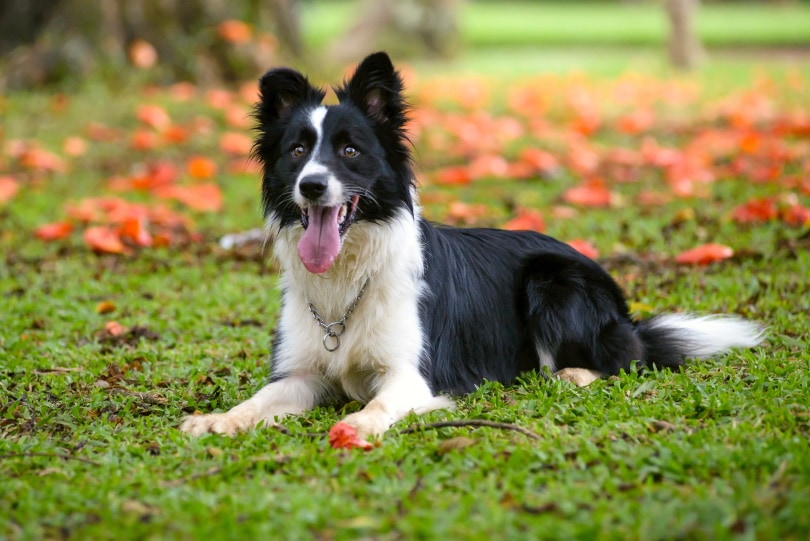
Training
Due to their high intelligence, Border Collie dogs are relatively simple to train. In fact, they rank among the top most intelligent breeds. They also have a strong herding instinct, which can make herding work a snap to train.
While they are trainable and intelligent, it doesn’t mean all training will be easy with a Border Collie. They typically aim to please, making them compliant and willing to listen to commands, but they also may be distracted by smaller animals they “need” to herd.
Sometimes, they may nip at the heels of children or other pets. Some people interpret this as an aggressive behavior, and while it is undesirable, it is not aggression.
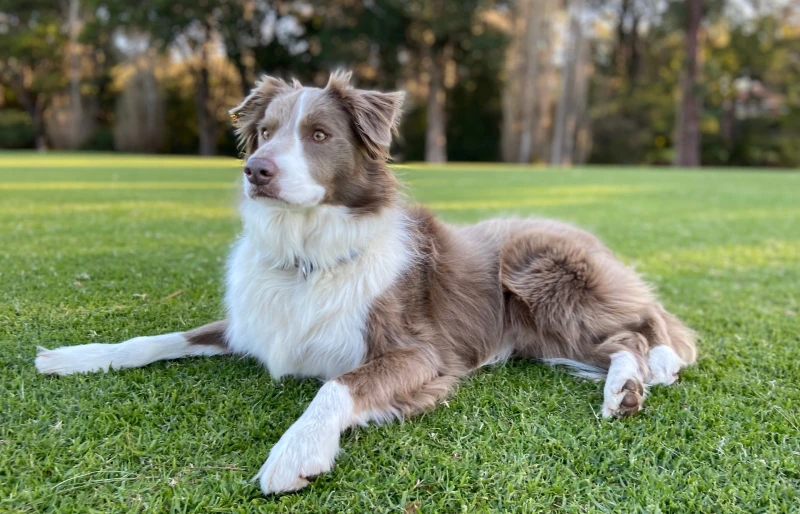
Exercise Needs
If you want a happy and cooperative Border Collie, give your dog at least 2 hours of exercise every day. They are great companions for jogging, biking, and hiking. Their exercise program should include more than just a walk or two around the block.
Border Collies excel at any sports and games they’re trained to do. They do very well in agility trials but can also do well with obedience, dock diving, cani-cross, and more.
Grooming
Border Collies have a double coat that requires routine maintenance. If you take them to a professional groomer, you’ll need to schedule an appointment every 4–6 weeks. However, since they don’t usually need haircuts, grooming can usually be done at home if you feel up to it.
A good bath and brushing can do wonders for a double coat. Plan to brush your Border Collie at least three times per week, but you’ll need to brush them more frequently when they blow their coats. Expect an increase in shedding and brushing needs during the spring and fall when your dog’s coat changes between seasons.
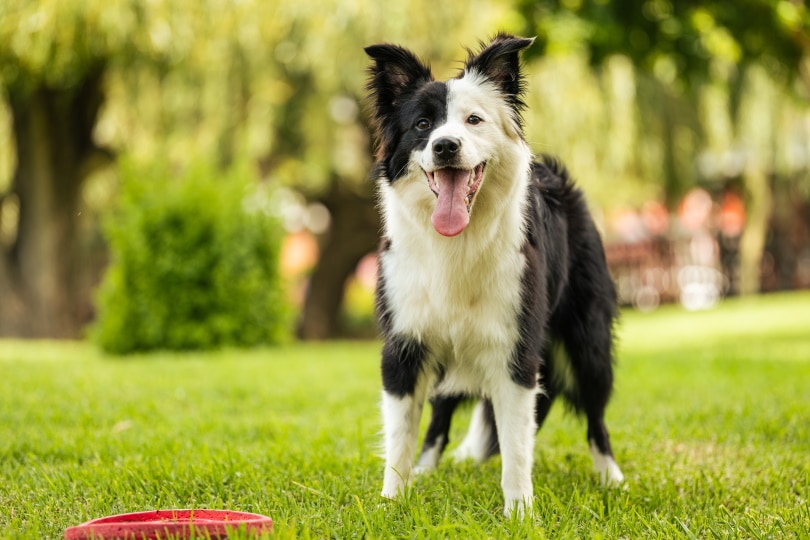
Suitable For:
Border Collies can be good dogs for families, but they are not the best pets for inactive owners or families. Their high exercise needs and energy levels, as well as their standoffishness with strangers, can make them challenging to control without proper training. A bored or under-exercised Border Collie will likely become anxious and begin acting out.
Australian Shepherd Overview
Temperament
Australian Shepherds typically have a no-nonsense personality that is up for an adventure. They are loyal and loving with their family and get along with other pets. They have an easygoing temperament and love playing with people, including children. They are tolerant of small children, but it’s important to teach your child to handle the dog properly to prevent nipping.
Aussies are usually friendly and outgoing and lack the wariness with strangers that the Border Collie often exhibits, although they may be a little shy with strangers at first. They are fiercely loyal dogs that usually bond with all of the people in the family, and they are known to be very protective of their people and their home.

Training
The Aussie is bright and easy to train, and their intelligence clocks in slightly below the Border Collie. They have a strong herding instinct that makes training herding easy. They are known to do very well at dog sports, and they can learn how to solve puzzles and play games.
Some Aussies have a slight stubborn streak, which can make training a challenge until you work out an effective training technique for your dog. They are usually motivated by high-value rewards, such as treats or toys. They are curious and protective enough that they may become distracted by what the other animals or people in the home are doing.
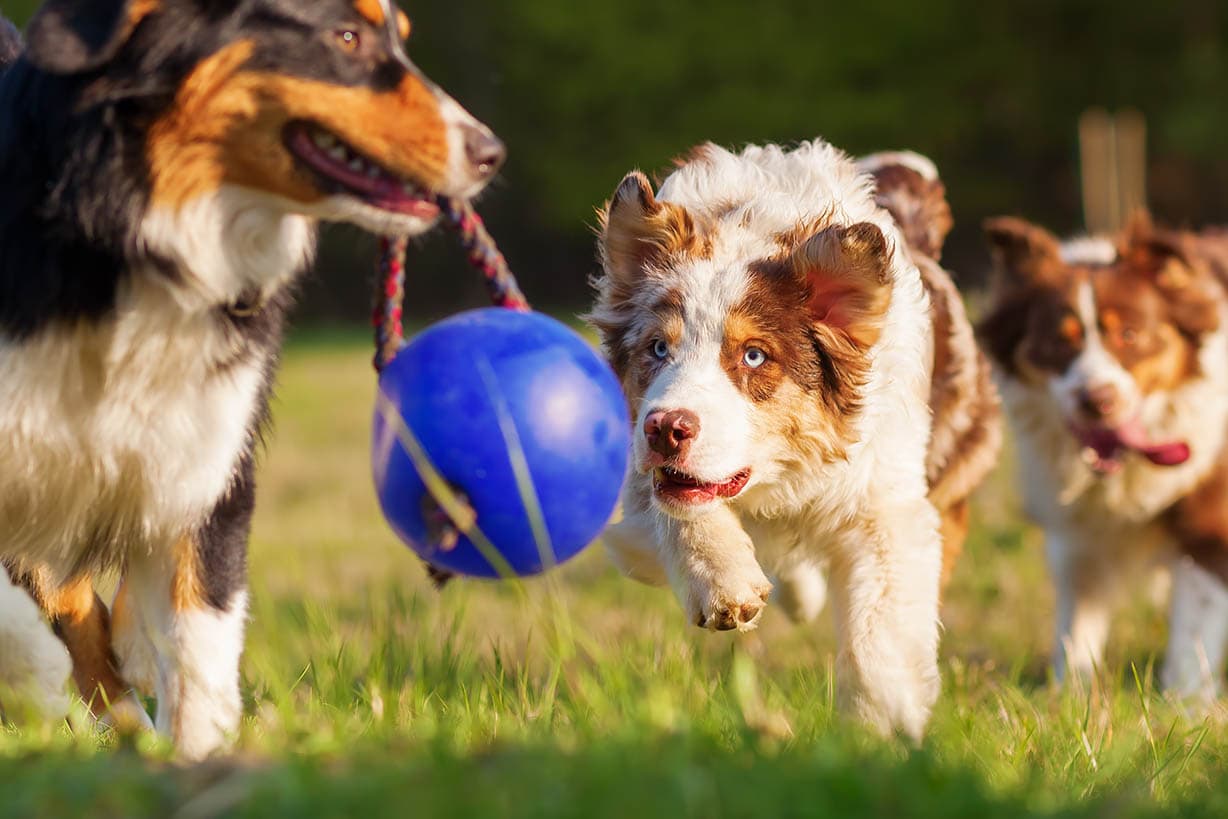
Exercise Needs
Aussies need at least 1½ hours of exercise per day, but 2 hours or more is ideal. They are great running and hiking partners, and their sense of adventure can make them entertaining to have with you. However, there are some breeding lines of Aussies that are a little less energetic than others. If you find a reputable breeder with Aussies, you can ask them about the energy levels of the parents to get an idea of how energetic the puppies will be.
Grooming
Australian Shepherds have a medium-length coat that is somewhat silky in texture. It requires routine brushing, and it can become tangled or matted in some areas if not properly cared for. Plan to brush your Aussie at least a few times weekly, but more may be necessary, especially during shedding seasons.
Aussies need baths every 4–6 weeks. This will help maintain the health of the skin and coat and distribute the natural oils on the skin across the coat. They rarely require trims, and it isn’t recommended to shave them since their silky coat helps insulate them.
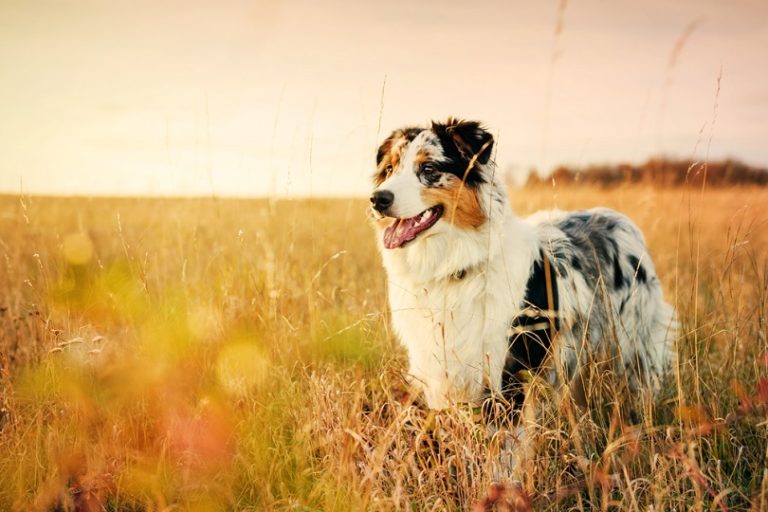
Suitable For:
Although there is the potential for shyness with strangers, Aussies are generally friendly and outgoing dogs. They are protective of their people but are known to be gentle and loving with children. They usually get along with other pets, and although they are known to nip at heels and attempt to herd like Border Collies, this is typically less common.
The Specifics of Owning Herding Breeds
Both the Border Collie and Australian Shepherd are herding dog breeds. They were bred for farm work and dealing with livestock, like sheep and cows. It has been deeply ingrained in their DNA to herd, and if they see some kind of grouping or pattern, they may feel very strongly that they need to start herding.
This herding behavior can be unusual and confusing for someone who has never owned a herding breed. If you search the internet, you’ll find videos of Border Collies and Aussies herding or attempting to herd machines, small animals, large animals, other pets in their home, people, and even trash.
When they are herding, they may nip at the heels of whatever they’re herding, which is how they handle livestock. For people unfamiliar with the behavior, the first time they see their dog nipping at their children’s heels can be frightening. It is a perfectly normal behavior for a herding dog, but it isn’t an ideal behavior to encourage.
If your dog is trained to perform a herding task, then it’s essential to train them to restrict their herding behavior to doing that specific job and nothing else. If your dog is just a family pet without a herding job, you might have to get creative in helping them burn off their strong desire to herd. Some owners prefer to provide other outlets for their dog’s energy, like running and doing dog sports. Other people may try to come up with things for their dog to herd, such as toys and balls.
Which Breed Is Right for You?
When trying to choose between the Border Collie and the Australian Shepherd, you should take a very honest look at your lifestyle. The Aussie is a better fit for more families than the Border Collie, but both dogs can be lovely pets for owners who meet their needs. Both breeds can become bored, anxious, and destructive without proper exercise.
You may realize that your home isn’t appropriate for either breed, and that is OK. They are not suitable for homes where everyone is gone for long periods. If you’re willing to put in the time, both breeds are exceptional dogs that will constantly amaze you with their trainability and intelligence. However, if you’re looking for a dog who can learn new tricks in seemingly no time flat, the Border Collie may be your top pick.
Related Reads:
- Sheltie vs Border Collie: Key Differences (With Pictures)
- English Shepherd vs. Border Collie: The Differences (With Images)
Featured Image Credit: Top – Eric Isselee, Shutterstock | Bottom – xkunclova, Shutterstock

